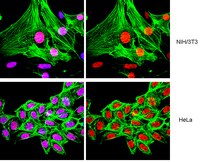17-10099 Sigma-AldrichChIPAb+ Acetyl-Histone H4 (Lys8) - ChIP Validated Antibody and Primer Set
The ChIPAb+ Acetyl-Histone H4 (Lys8) set includes the Acetyl-Histone H4 (Lys8) antibody, a negative control rabbit serum & qPCR primers which amplify a 134 bp region of human HSPCA.
More>> The ChIPAb+ Acetyl-Histone H4 (Lys8) set includes the Acetyl-Histone H4 (Lys8) antibody, a negative control rabbit serum & qPCR primers which amplify a 134 bp region of human HSPCA. Less<<Recommended Products
Přehled
Tabulka spec. kláve
| Species Reactivity | Key Applications |
|---|---|
| H, Yeast (S. cerevisiae) | WB, ChIP |
| Product Information | |
|---|---|
| Format | Serum |
| Control |
|
| Presentation | Anti-Acetyl-Histone H4 (Lys8) (rabbit polyclonal). One vial containing 50 μL of antiserum containing 0.05% sodium azide. Store at -20°C. Normal Rabbit Serum. One vial containing 100 μL of antiserum containing 0.05% sodium azide. Store at -20°C. ChIP Primers, HSPCA. One vial containing 75 μL of 5 μM of each primer specific for human HSPCA. Store at -20°C. FOR: GCA ACA GCT ACC ACA GGA CCA REV: GAG CGT GTG AAA TCA ACA TAA AGC |
| Quality Level | MQ100 |
| Packaging Information | |
|---|---|
| Material Size | 25 assays |
| Material Package | 25 assays per set. Recommended use: ~2 μL of antibody per chromatin immunoprecipitation (dependent upon biological context). |
| Global Trade Item Number | |
|---|---|
| Katalogové číslo | GTIN |
| 17-10099 | 04053252745959 |










